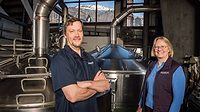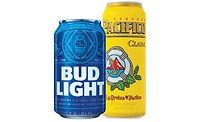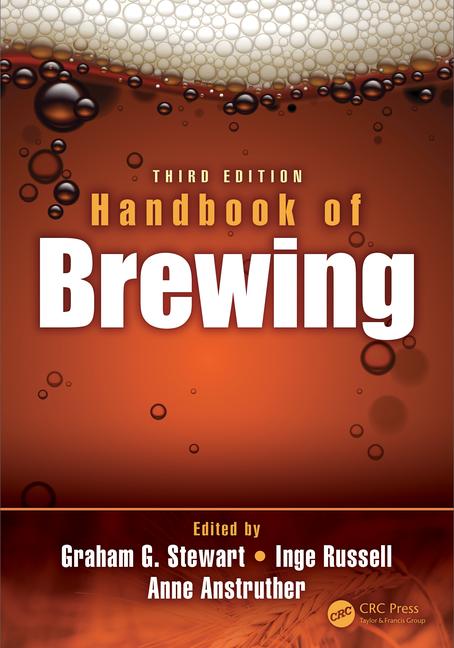Alaskan Brewing Co.: Influenced by Climate and Traditions
Alaskan Brewing Co.: Influenced by Climate and Traditions
By ELIZABETH FUHRMAN
The capital of Alaska, Juneau, resides at the base of 3,800-foot mountain peaks on a small strip of land on the waterfront of the Gastineau Channel. Between the ice fields and glaciers, Juneau houses Alaskan Brewing Co., the eighth-largest craft brewer and 19th overall brewing company, according to 2006 sales as tabulated by the Brewers Association.
This year, Alaskan Brewing expects to grow to nearly
120,000 barrels, up from the 106,000 barrels the company brewed in 2006,
says Geoff Larson, founder, Alaskan’s brewmaster and co-owner along
with his wife Marcy Larson. Next year, Alaskan Brewing expects to grow to
150,000 barrels.
While Juneau offers Alaskan Brewing water aged 10,000
years from snow, glacier and ice fields and the ease of natural cold
fermentation, it also creates a logistical challenge. The town of 30,000
people is only accessible by air and sea, with no road connections.
“We’re in a city in the middle of the
fifth-largest ice field in North America,” Geoff says.
“We’re on a fjord. It’s picturesque. It’s
beautiful. But we only get shipments to the plant once a week.”
One thing Alaskan Brewing embraced from the beginning
was the need to plan very carefully, whether it was receiving raw materials
or shipping products.
“Part of our success is passion,” Geoff
says. “We love what we do, but I think grounding it with a little bit
of reality is that we know we just can’t do it tomorrow. We have to
make sure we have everything planned out.”
Celebrating its 21st year in business, the brewer knew
since its founding that it wasn’t going to be producing beer just for
its neighbors, but for long-range distances, Geoff says. From Juneau,
Alaskan Brewing’s next largest markets are 800 miles away in
Anchorage, Alaska, and Seattle.
“We knew we had to make a beer that would be
able to travel, would be consistent and would be good in either of those
locations as well as here at home,” Geoff says. “That set the
tone for how we were producing. We are very well known for our consistency
and our dependability. When you grab a bottle of our beer you can count on
what it’s going to taste like.”
Alaskan Brewing first met the distribution challenge
of transporting to Anchorage and Seattle, and expanded continuously down
the Pacific Coast in a pattern that helped them efficiently handle freight
costs, Marcy says.
The brewer now distributes in nine states, including
Alaska, Washington, Montana, Idaho, Oregon, Nevada, California, Wyoming and
its newest market, Arizona.
In addition to Alaska’s landscape, the
state’s heritage has influenced the brewing of its eight beers.
Educated as a chemical engineer, Geoff’s engineering background
encouraged his investigation of flavors in his homebrewing. When the idea
formulated to turn Geoff’s hobby into a profession, Marcy embarked on
researching old breweries in Alaska. The couple found records from Douglas
City Brewing Co., one of the five local breweries that existed before
Prohibition in the Juneau and nearby Douglas Island area, dating from 1907
that inspired them to brew the company’s flagship Alaskan Amber.
“We were able to match the history, which we
really love Alaska and its colorful history, and match that with the beers
that we make,” Marcy says. “It’s a really good endeavor
for us.”
With its cold-fermentation
process, Alaskan Amber takes longer to ferment than a traditional ale
would, which makes it smoother than most ales, Geoff says.
“It’s almost a lager of ales,” he says.
And the Amber is clearly influenced by its
environment. “Cold fermentation is a heck of a lot easier up here in
Alaska than it is anywhere else,” Marcy explains. “It’s
natural.”
The introduction of the Alaskan Amber into the Seattle
market as well as its first medal at the Great American Beer Festival in
1987 really helped the brewery grow. Alaskan Brewing added Alaskan Pale Ale
the next year.
Also directly influenced by its Alaskan environment,
the brewer’s lineup includes the award-winning Alaskan Smoked Porter,
a dark beer inspired by the smoky nature of foods and brewing of more than
200 years ago. Prior to brewing, selected malts are smoked in small batches
under controlled conditions in a commercial food smoker using local alder
wood. History also roused the creation of Alaskan Winter Ale, which is
brewed in the style of an English old ale, and balances the sweet heady
aroma of Sitka spruce tips and hops.
This year, Alaskan Brewing launched its first beer
since 2002 with the introduction of Alaskan IPA. The India Pale Ale was
created in a series of R&D batches, which in this case stands for rough
draft batches, for its mini test market of Juneau. Alaskan Brewing
encourages employees from different departments to collaborate to
investigate certain beer styles.
“We will start the investigation on a one-barrel
level and go up to 10 barrels, and it might go up to 100 barrels,”
Geoff says. “Rough draft really became the precursor of the testing
grounds for products that may become commercially available year-round, and
IPA was one of those.”
Alaskan IPA’s label takes it cues from a surfing
culture of Yakutat, Alaska. One percent of proceeds from Alaskan IPA will
go to improve the health of the Pacific Ocean and coastlines in an
initiative called the Coastal CODE (Clean Oceans Depend on Everyone).
Alaskan Brewing rounds out its lineup with Alaskan
Stout, ESB and Summer Ale. “The lineup we have can appeal to the
people who are interested in some of the more esoteric styles to people who
are for the first time venturing into the craft category and wanting to try
a product,” Geoff says.
Because the logistics of transportation to the lower
48 states creates a large financial hurdle for the company and wholesalers,
Alaskan Brewing ales fall on the high end of the craft beer category.
“The wholesaler needs to have a comfort level
with that and understand the story,” Geoff says.
With the craft beer category continuing its upward
trend, the Larsons see it as a sign that consumers are eager to venture
outside traditional brands.
“For $1 or $2 more a six-pack, they can buy a
world-class beverage,” Geoff says. “And it has an amazing
spectrum of flavors that maybe isn’t what people would have expected.
The consumer can’t say that with wine; can’t say that in
spirits … The long term is extremely
exciting for the category.”
Looking for a reprint of this article?
From high-res PDFs to custom plaques, order your copy today!






